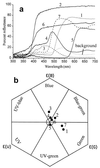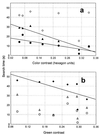Visual constraints in foraging bumblebees: flower size and color affect search time and flight behavior
- PMID: 11259668
- PMCID: PMC31150
- DOI: 10.1073/pnas.071053098
Visual constraints in foraging bumblebees: flower size and color affect search time and flight behavior
Abstract
In optimal foraging theory, search time is a key variable defining the value of a prey type. But the sensory-perceptual processes that constrain the search for food have rarely been considered. Here we evaluate the flight behavior of bumblebees (Bombus terrestris) searching for artificial flowers of various sizes and colors. When flowers were large, search times correlated well with the color contrast of the targets with their green foliage-type background, as predicted by a model of color opponent coding using inputs from the bees' UV, blue, and green receptors. Targets that made poor color contrast with their backdrop, such as white, UV-reflecting ones, or red flowers, took longest to detect, even though brightness contrast with the background was pronounced. When searching for small targets, bees changed their strategy in several ways. They flew significantly slower and closer to the ground, so increasing the minimum detectable area subtended by an object on the ground. In addition, they used a different neuronal channel for flower detection. Instead of color contrast, they used only the green receptor signal for detection. We relate these findings to temporal and spatial limitations of different neuronal channels involved in stimulus detection and recognition. Thus, foraging speed may not be limited only by factors such as prey density, flight energetics, and scramble competition. Our results show that understanding the behavioral ecology of foraging can substantially gain from knowledge about mechanisms of visual information processing.
Figures





References
-
- Wolf T J, Ellington C P, Begley I S. Insectes Soc. 1999;46:291–295.
-
- Heinrich B. Bumblebee Economics. Cambridge: Harvard Univ. Press; 1979.
-
- Schaffer W S, Jensen D B, Hobbs D E, Gurevitch J, Todd J R, Schaffer V. Ecology. 1979;60:976–987.
-
- Dukas R, Clark C W. Ecology. 1995;76:1320–1326.
-
- Heinrich B. Am Zool. 1983;23:273–281.
Publication types
MeSH terms
LinkOut - more resources
Full Text Sources

